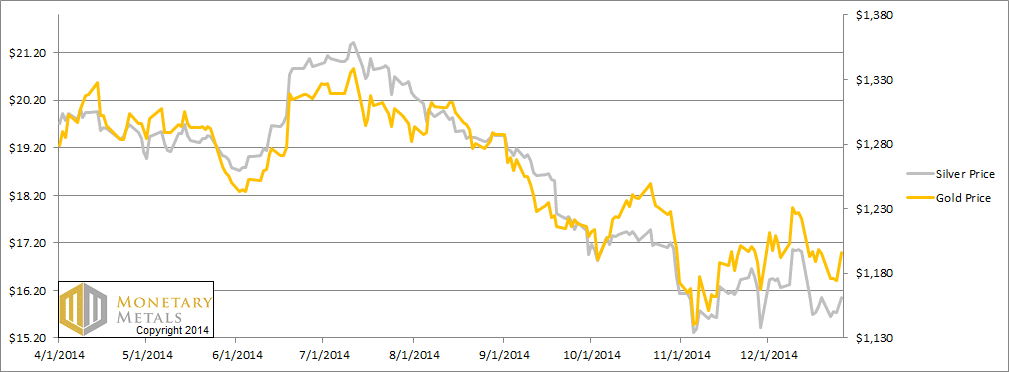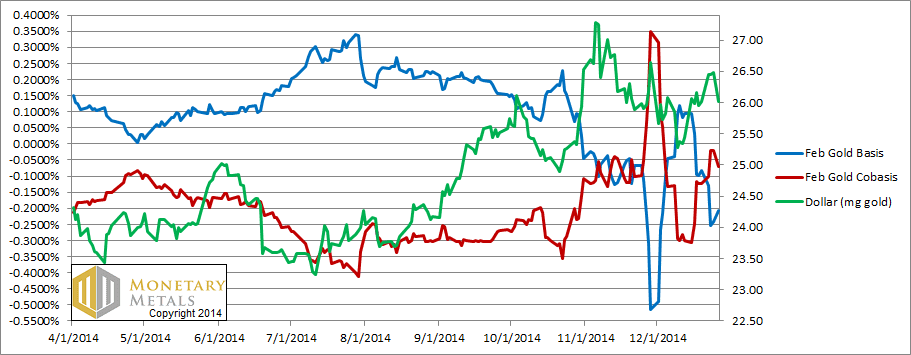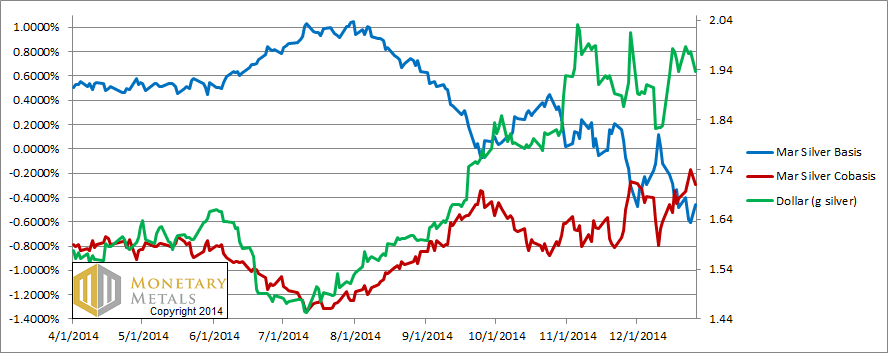Monetary Metals Supply and Demand Report: 28 Dec, 2014
The prices of both gold and silver (as measured in dollars) fell on Monday and rose on Friday, basically unchanged on the week.
Not only was there little change, and not only was it a shortened holiday week, but it was a light week in terms of trading volumes. We would be inclined to discount big changes in the basis and cobasis, should they occur. For a pictures of them, read on…
First, here is the graph of the metals’ prices.
We are interested in the changing equilibrium created when some market participants are accumulating hoards and others are dishoarding. Of course, what makes it exciting is that speculators can (temporarily) exaggerate or fight against the trend. The speculators are often acting on rumors, technical analysis, or partial data about flows into or out of one corner of the market. That kind of information can’t tell them whether the globe, on net, is hoarding or dishoarding.
One could point out that gold does not, on net, go into or out of anything. Yes, that is true. But it can come out of hoards and into carry trades. That is what we study. The gold basis tells us about this dynamic.
Conventional techniques for analyzing supply and demand are inapplicable to gold and silver, because the monetary metals have such high inventories. In normal commodities, inventories divided by annual production can be measured in months. The world just does not keep much inventory in wheat or oil.
With gold and silver, stocks to flows is measured in decades. Every ounce of those massive stockpiles is potential supply. Everyone on the planet is potential demand. At the right price, and under the right conditions. Looking at incremental changes in mine output or electronic manufacturing is not helpful to predict the future prices of the metals. For an introduction and guide to our concepts and theory, click here.
Next, this is a graph of the gold price measured in silver, otherwise known as the gold to silver ratio.
The Ratio of the Gold Price to the Silver Price
For each metal, we will look at a graph of the basis and cobasis overlaid with the price of the dollar in terms of the respective metal. It will make it easier to provide terse commentary. The dollar will be represented in green, the basis in blue and cobasis in red.
Here is the gold graph.
The Gold Basis and Cobasis and the Dollar Price
No change in price, a minimal change in the bases. If we had to take a wild guess, perhaps traders were out on holiday this week.
Now let’s look at silver.
The Silver Basis and Cobasis and the Dollar Price
A slight rise in the cobasis, but Boromir had a chore to do back in Gondor this week, something about a ring made of gold…
© 2014 Monetary Metals







Happy New Year Keith !
What jmf said, Keith!
You’re such a breath of lucid air (I mix metaphors when I like) given that I also read KWN daily.
Thanks! :)
Happy New Year Keith – and thanks again for all the great commentaries!!